The Museum Collections
Introduction
I. History and Art Collection
1. Icons of the 14th – 19th centuries
icons of the 14th – 17th century
2. Jewelry art of the 14th – 20th century
jewelry art of the 14th – 17th century
jewelry art of the 18th – 19th century
the european silver 14th - 19th centuries
3. Small-size sculptures (works of metal, wood, bone)
XI – the beginning of the XX century
Small-size sculptures 11th – 17th century
Small-size sculptures 18th – early 20th century
enamel of Troitza masters 15-8th – early 20th century
5.Embroidery, lace, textiles of the 14th - early 20th century
icon and ornamental embroidery
gold and silver lace
6.Painting of the 18th – 21st centuries
painting of the 18th – 19th centuris
painting of the 20th – 21st centuris
II.Manuscripts and old printed books of the 14th – 17th century
IV.Lithography of the 18th – 19th century
V.Numismatics
VI.Medals of the 18th - early 20th century
VIII.Archeology collection
IX. Russian folk and applied and decorative art of the 17th – 21st c.
1. Artistic wood
folk carved and painted wood
wooden toys
house carving of Sergiev Posad
Khokhloma and Gorodets painting
2. Artistic textiles
embroidery and weaving
printed textiles and lace
Russian shawls
folk costumes
folk garments
printed cotton kerchiefs
|
The numismatics collection(p.2) |
Stamping date began located on Peter I coins since 1696. In the beginning it was counted according to a notation of time traditional in Russia - from «world creation» and designated by the letters of the slavic alphabet corresponding to certain numbers. With introduction since 1 January of new chronology from «Christmases Christ's» dates on coins began designated on again entered system and gradually letters replaced with the "Arabian" figures.
On some copper and silver coins of Peter I’s epoch used original reception at a designation of their cost: for grammatical man the value designated by a word and figures, for illiterate - corresponding quantity of points or hyphens (Ill. 12). This way applied up to 1810.
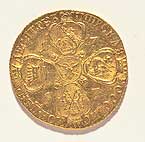
10. Ten roubles. 1767. Gold.
|
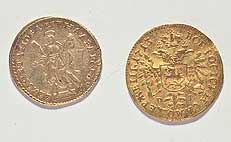
11. Two roubles. 1722. Gold.
|
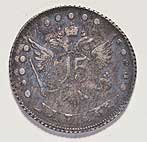
12. 15 kopecks. 1765. Silver.
|
In 1730 - the beginning of 1760th years in 6 times the volume of stamping of a copper coin has increased, but the silver coin remained the basic.
So-called senior coins (rouble, half rouble”, “chetvertack” (25 kopecks) had the general "Petrovsky" type - a combination a portrait (face&breast) with the State Emblem. «The century of empresses» has left on coins the big variety of female portraits (Ill. 13-17).
ŃThe unique, very rare coin presented to a museum collector O.V.Kulakov is allocated among other silver coins of this time. This coin one rouble (1741) has stamped during government of Ivan VI (Ivan Antonovich) (Ill. 18). Ivan VI, the son of the niece of Empress Anna Ioannovna, formally reigned the first year of the life (17.10.1740 - 25.11.1741) at first at the regency Byron, and then at his mother, Anna Leopoldovna. He has not crowned on a throne. Ivan Antonovich's coins have minted only nine months. Approximately until the end of January 1741, when the sample of new coins with Ivan's VI portrait has been confirmed, stamping of silver coins with Anna Ioannovny's portrait proceeded, dated 1740. The reason of it were difficulties, which have arisen at creation for coins of the new sample of a comprehensible portrait of the two-month emperor.
|
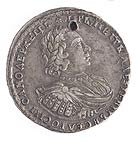
13. One Rouble. 1721. Silver.
|
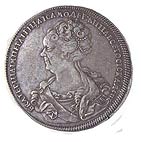
14. One Rouble. 1725. Silver.
|
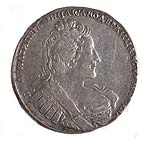
15. One Rouble. 1733. Silver. |
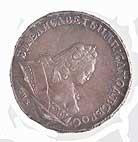
16. One Rouble. 1744. Silver.
|
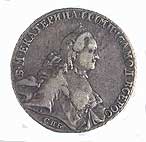
17. One Rouble. 1763. Silver.
|
Ŕlready in November 1741, after Elizabeth Petrovna's accession, a coin with Ivan Antonovich's image began to be withdrawn from circulation and over-minted in Elizabeth's corresponding coins. According to the decree from 31 December 1741, the exchange of coins was made at full cost, then, till June 1745, with course fall. Since July 1745 coins have withdrawn impecuniously, and their holders were inflicted to severe punishment. Change silver coins were a ten-kopeck coin and “pyatak” (5 kopecks), in 1760 for the first time there were coins in 20 and 15 kopecks.
The basic tendency of shifts in monetary balance of the country of 18th century consisted in steady increase of a role of a copper coin. Stamping a copper coin brought in the greatest incomes to treasury, it became the main payment means in the country. Silver used for the foreign trade operations and the treasury payment of expenses abroad. Gold coins went mainly on a covering of annually increasing palace and military expenses. Ten-rouble and five-rouble coins and coins of smaller advantage – “half rouble” and rouble have minted basically (Ill. 19).
In second half of 18th century the coin of "5 kopecks» in weight on the average 51 ă became the basic copper coin, which mass mint there has begun Elizabeth Petrovna in 1758 (Ill. 20-21). The considerable quantity of these coins has arrived in a museum as a part of several enough the large treasures found in territory of the Zagorsk area (they are described in the book: L.M. «Treasures of coins tell») Stamping of such large five-kopeck coin has stopped with accession of Paul I.
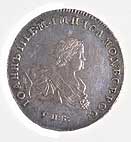
18. One Rouble. 1741. Silver.
|
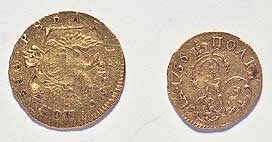
19. One Rouble. 1756. Half-ooze. 1756. Gold.
|
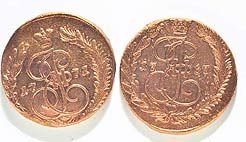
20. 5 kopecks (front). 1767, 1771. Copper.
|
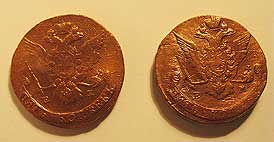
21. 5 kopecks (back). 1767, 1771. Copper.
|
|


